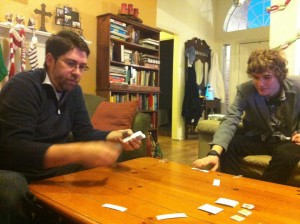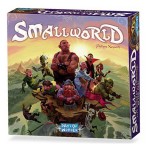How would you like to discover an activity that will:
 entertain you and your family for hours each week?
entertain you and your family for hours each week?- pull your kids off of the “screens”—TV, iPad, computer, and phones?
- create “face time” in your family, with all of you looking across a table at each other, talking, discussing, and laughing?
- build your kids’ brain power, their social skills, and even their ability to plan and make wise decisions?
Would you be surprised if I said that the lowly board game is the lost ticket to this kind of engagement and fun?
I am selling nothing in this post (truly!). But I believe so strongly in the modern board game, and am so convinced that playing more games will be of such benefit to modern families, that I can’t remain silently any longer. I have to tell you why you need to play a modern board game tonight.
But notice that word “modern.” I’m not talking about digging back through the dusty games cabinet to pull out Monopoly, Pick-Up Sticks, or Yahtzee. In the last twenty years, a new wave of board games has been growing in popularity, fueled by their ability to appeal to a wide range of players—young and old, busy and bored, extroverted and introverted, smart and not-so-smart. If you haven’t tried—or even heard of—a modern game like Settlers of Catan or Ticket to Ride, you’ve been missing out on the greatest resource for engagement and togetherness around, and the best antidote to the modern pandemic of everybody-on-a-screen-all-the-time. Family engagement and togetherness, yes—but also personal engagement and enjoyment. Miss out no longer!

Americans are far behind the rest of the world when it comes to the games we play. The games you grew up with have long since been surpassed by a new crop of games that have emerged since the mid-90s. Many of these games are designed in Germany—where board gaming is a common family past time—and for this reason are often called “German-style games” or “Euro games.” Since players and designers outside of Europe—Americans and others all around the world—have taken up this style of game, I prefer to call them “modern board games.”
And if you’re not playing them, you should.
You wouldn’t think that the trusty old cardboard-cards-and-dice game would be ripe for innovation. But innovate they have. Modern board games feature designs and elements that make them simply better—funner, faster, more smiles and fewer frowns—than the games you grew up with.
To understand how, you have to understand what’s wrong with the games you’re used to.
When an American thinks “board game,” they think of Monopoly, Chess, or a party game like Outburst. None of these games live up to the sheer enjoyment of a modern game like Settlers of Catan, Ticket to Ride, or Small World.

Monopoly is a horror. It’s a badly-designed game, first created over a century ago, that has somehow stuck as an American favorite. Alas, it has left millions of victims feeling beaten down over the course of endless hours by other players who seem to win by mere cruelty and sheer luck. Despite its status as the king of classic board games, Monopoly stands against everything that games are about: fun for all, fairness, a sense of competency and control (even for beginners), and the elimination of boredom—keeping everyone engaged all the time. When you think “board game”, banish Monopoly from your mind. (Burning a copy or two may help with the purging.)
Chess is the second game we tend to think of. And indeed it’s a wonderful game. But it’s also at the high end of intellectual intensity and abstraction. It’s fun—but it’s not for everyone. When you think “board game”, don’t think Chess.
Outburst is fun. But it’s not a board game in the full sense of the phrase. It belongs to the rampant horde of party games—games that emphasize social and verbal skills almost to the exclusion of any other kind of play. Other games in this category include Apples to Apples, Balderdash, Scategories, Pictionary, Guesstures, Things, Cranium, and Taboo. Party games are tremendously popular in America. If we’re not playing a video game, we’re probably playing a party game. And they’re genuinely fun and social—two of the main advantages of board games in general. But when you think “board game”, think beyond party games. If board games are food, party games are angel food cake. A diet without angel food would be a sadder, poorer diet; but a diet consisting only of angel food would be fattening, bland, tiring, and empty. Play party games, enjoy them—but don’t stop there. When you plan a game night, mix other kinds of board games in with party games for a more satisfying, more well-rounded, and just plain funner evening.
So when you think “board game”, don’t think Monopoly, Chess, or Outburst. What, then, should you think?
First, think variety. Literally thousands of delightful new board games have been designed since the early 90s, and no two of them are just the same.
What the best of them offer are:
- Accessibility. You can learn them—quick. Even if you’re young. Even if you’re not the sharpest knife in the drawer. You can get playing in a few minutes.
- Speed. You remember the old days when you would wait 5 or 10 minutes (or more!) for another player to complete his or her turn? Those days are gone. Modern games keep players moving, with turns often taking just a few seconds. Also interesting are games that keep you involved by giving you something to do on other players’ turns (as in Modern Art or Settlers of Catan). Or you may find games in which players don’t really take turns, but all play more or less simultaneously (Niagara comes to mind). Modern games keep you engaged—all the time.
- Interaction. Modern board games get you talking with other players—making deals, trading with them, laughing with them. There is an element of extroversion—of people-time—in almost all of the new games.
- Depth. Despite this emphasis on accessibility and social interaction, modern board games will keep your brain humming. The rules tend to be easy to learn, but the decisions tend to be nuanced. I’ve been playing Settlers of Catan for almost 20 years, and I still haven’t figured out the One Grand Strategy. Every decision is intriguing, and every game is new.
- Fairness. What’s worse than going bankrupt in a game of Monopoly only to watch your friends keep playing for another two hours? Possibly this: playing Chess or Risk against an experienced friend who trounces you during your first game. Modern board games avoid these problems. Nobody gets eliminated early: everyone finishes at the same time. Beginners can win and often do. Modern games feel fairer than the old games, and this tends to make for happier players.
These qualities make for board games that get you playing quickly and keep you smiling and thinking from first to last. If you haven’t tried one of the modern board games, run out and buy one now. Target mixes some modern games in with the party games and the classics. Your local Barnes and Noble has developed a serious modern board game section over the last couple of years. If you live in a larger community you’ll probably find a board game store (probably lumped in with comics) in the area. And of course there’s always Amazon.
Which games should you try? Here’s a shortlist of the most popular modern board games that most people—not just most gamers, but most human beings—seem to love.
 Settlers of Catan. The first Euro game to make a splash in America, and probably the most popular. Puts players in the shoes of people settling a new island. Trading with other players is the heart of the game, but building your settlement is where the contest happens. Hard to go wrong with this one.
Settlers of Catan. The first Euro game to make a splash in America, and probably the most popular. Puts players in the shoes of people settling a new island. Trading with other players is the heart of the game, but building your settlement is where the contest happens. Hard to go wrong with this one. Carcassonne. The quickest and easiest of the modern board games, but still offers intrigue and depth. Take turns building a medieval city with its winding roads and markets.
Carcassonne. The quickest and easiest of the modern board games, but still offers intrigue and depth. Take turns building a medieval city with its winding roads and markets. Ticket to Ride. Plan train routes across 19th-century America, blocking off your friends before they get the sweet routes. I find that no other game keeps my mind riveted as deeply and pleasantly as this one. Another quick-playing game: if a turn takes longer than 10 seconds, it’s too long.
Ticket to Ride. Plan train routes across 19th-century America, blocking off your friends before they get the sweet routes. I find that no other game keeps my mind riveted as deeply and pleasantly as this one. Another quick-playing game: if a turn takes longer than 10 seconds, it’s too long. Small World. Think Risk, only funner, funnier, and less cut-throat. Players spread empires of elves, dwarves, trolls, and the like over a continent that’s a little too tight to hold them all, resulting in bouts of friendly annihilation. There’s a bit more to learn here than in the other games on this list, but it’s still very accessible, and the wonderful artwork pulls in new players.
Small World. Think Risk, only funner, funnier, and less cut-throat. Players spread empires of elves, dwarves, trolls, and the like over a continent that’s a little too tight to hold them all, resulting in bouts of friendly annihilation. There’s a bit more to learn here than in the other games on this list, but it’s still very accessible, and the wonderful artwork pulls in new players. Agricola. You’re a farmer raising sheep and carrots and cattle and such, building the biggest farm you can while keeping yourself and your growing family fed. This was the most popular modern board game throughout the late 2000s, and for good reason.
Agricola. You’re a farmer raising sheep and carrots and cattle and such, building the biggest farm you can while keeping yourself and your growing family fed. This was the most popular modern board game throughout the late 2000s, and for good reason.
Kids over the age of 8 or so could learn and enjoy any of these. Do yourself a favor. Try one. Tonight.







Comments are closed.